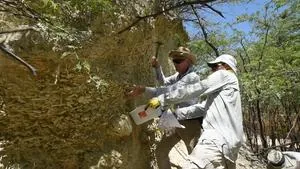
Unveiling the Past: Ancient Reefs Show Human Fishing's Impact on Caribbean Ecosystems
2025-06-30
Author: Wei Ling
Fossils Tell a Different Story
When we picture fossils, visions of colossal dinosaurs often dominate our imagination. Yet, the fossil record is also rich with the remnants of smaller marine life, such as fish and corals, that shed light on the ancient state of our oceans.
A Groundbreaking Study of Ancient Reefs
Scientists at the Smithsonian Tropical Research Institute (STRI) have conducted a remarkable study on fossilized coral reefs located in Panama's Bocas del Toro Province and the Dominican Republic. Dating back 7,000 years, these exceptional fossils serve as a rare glimpse into the Caribbean reefs before human interference. Hidden within the sediments, researchers uncovered thousands of fish ear bones and shark scales, enabling them to reconstruct entire ancient marine communities.
Dramatic Changes Uncovered
The astonishing results unveil a significant shift in fish populations over time. Sharks have plummeted by an alarming 75%, while fish targeted by humans have shrunk by 22%. Surprisingly, the prey fish species, those that fall victim to predators like sharks, have not only doubled in numbers but also increased in size by 17% in modern reefs. This study marks the first clear evidence of the "predator release effect"—a phenomenon where the removal of top predators allows prey species to thrive.
Resilience Amidst Change
Yet, amid these striking changes, the tiniest reef fish that find refuge in coral nooks have shown remarkable resilience, exhibiting no changes in size or population over the millennia. This stability suggests these small fish have remained largely unaffected by the extensive shifts occurring higher up the food chain.
In-Depth Research Techniques
To compare ancient and contemporary reefs, scientists meticulously examined thousands of skeletal remains, including unique shark skin denticles, known for their sandpapery texture. They also scrutinized fish otoliths—calcium structures in fish ears that reveal growth patterns, allowing the estimation of a fish's size at death.
Key Findings on Fish Behavior
Interestingly, this study also explored behavioral fossils. Researchers measured damselfish bite marks on coral branches from both ancient and modern specimens and found that the number of bites has surged in recent times, further supporting the increase in prey fish populations.
Implications for Conservation Efforts
These findings indicate a stunning transformation in the food webs of modern Caribbean reefs: with fewer sharks to keep prey fish populations in check, these smaller fish have thrived, growing larger and more abundant. However, the stability of the reef-sheltered fish suggests that water quality and habitat degradation were not the driving forces behind the changes in community structures.
This groundbreaking research, published in the Proceedings of the National Academy of Sciences (PNAS), highlights the power of the fossil record for future conservation efforts. By unveiling the structure of reefs prior to significant human fishing activities, these ancient fossils provide essential baseline data, crucial for understanding the evolution of coral reef ecosystems and their resilience.
Collaborative Research Efforts
Conducted in collaboration with various esteemed institutions, including the Marine Science Institute at the University of Texas at Austin and The Nature Conservancy, this study exemplifies how interdisciplinary research can illuminate the past, guiding us toward better conservation strategies for the future.

 Brasil (PT)
Brasil (PT)
 Canada (EN)
Canada (EN)
 Chile (ES)
Chile (ES)
 Česko (CS)
Česko (CS)
 대한민국 (KO)
대한민국 (KO)
 España (ES)
España (ES)
 France (FR)
France (FR)
 Hong Kong (EN)
Hong Kong (EN)
 Italia (IT)
Italia (IT)
 日本 (JA)
日本 (JA)
 Magyarország (HU)
Magyarország (HU)
 Norge (NO)
Norge (NO)
 Polska (PL)
Polska (PL)
 Schweiz (DE)
Schweiz (DE)
 Singapore (EN)
Singapore (EN)
 Sverige (SV)
Sverige (SV)
 Suomi (FI)
Suomi (FI)
 Türkiye (TR)
Türkiye (TR)
 الإمارات العربية المتحدة (AR)
الإمارات العربية المتحدة (AR)